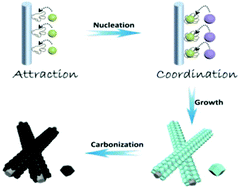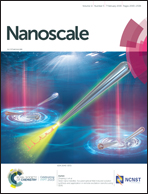Polarity-assisted formation of hollow-frame sheathed nitrogen-doped nanofibrous carbon for supercapacitors†
Abstract
Heteroatom-doped carbon nanostructures with uniform size and morphology, well-designed architectures, and minimized interfacial resistance have been recognized as promising electrode materials for energy storage, but remain a crucial challenge. Herein, we develop a general approach of polarity-induced decoration of a monolayer sheath of metal–organic framework (MOF) particles with excellent uniformity in size and morphology on electrospun polymer nanofibers. These hybrid nanofibers are facilely converted into nitrogen-doped nanofibrous carbon (denoted as N-NFC) during pyrolysis. The thus-obtained N-NFC features (1) a one-dimensional nanofibrous structure with a highly conductive core, (2) a monolayer sheath of hollow carbon-frames with uniform size and morphology, (3) plenty of micro/mesopores with a highly accessible surface area, and (4) a high N-doping level, all of which guarantee its good electrochemical performance with a high capacitance of 387.3 F g−1 at 1 A g−1. In a solid-state supercapacitor, it delivers excellent rate capability (78.0 F g−1 at 0.2 A g−1 and 64.0 F g−1 at 1 A g−1), an enhanced energy density of 7.9 W h kg−1 at a power density of 219 W kg−1, and outstanding cycling stability with 90% capacity retained over 10 000 cycles at 1 A g−1.



 Please wait while we load your content...
Please wait while we load your content...